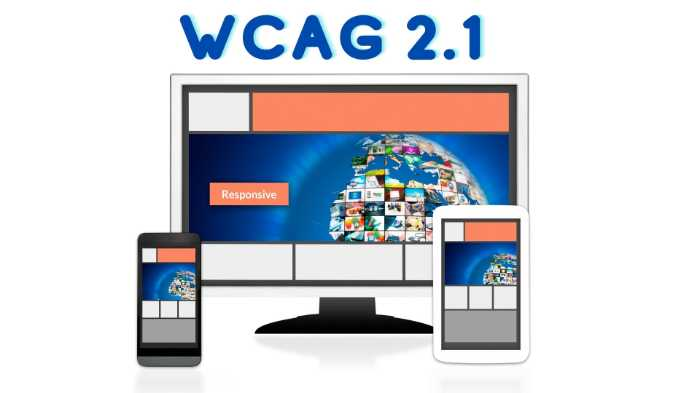If you’re running a website, it’s important to make sure that all of your content is accessible to everyone. This is where WCAG 2.0 comes in – it’s a set of guidelines that help web developers create websites that are accessible to people with disabilities. In this blog post, we’ll discuss what WCAG 2.0 is, and how you can make your website compliant with these guidelines.
- What is web accessibility?
- What is the web accessibility initiative?
- What is WCAG 2.0 and why is it important?
- What are the user interface components?
- What are the benefits of WCAG standards?
- FAQs
What is web accessibility?

Web accessibility is the inclusive practice of making websites usable by people of all abilities. This includes people with visual, hearing, motor, and cognitive disabilities, as well as those with temporary or situational impairments (such as broken limbs or fatigue). When done properly, web accessibility benefits everyone by making the web a more user-friendly place. It also helps to ensure that everyone has equal access to information and opportunities online.
There are a variety of ways to make a website more accessible, including adding alt text to images, providing transcripts for audio/video content, and using clear and concise language. By taking these steps, website owners can help make the web a more inclusive and welcoming place for everyone.
What is the web accessibility initiative?
The web accessibility initiative (WAI) is an effort by the World Wide Web Consortium to make the Internet more accessible to people with disabilities. The initiative includes a set of guidelines for developers to follow when creating web pages and web applications. These guidelines cover a wide range of topics, including navigability, content presentation, and functionality. By adhering to these guidelines, developers can help ensure that their products are accessible to a wider audience.
In addition to the guidelines, the initiative also provides tools and resources for testing and evaluating web accessibility. By making use of these resources, developers can further improve the accessibility of their products. Ultimately, the goal of the WAI is to make the internet more inclusive for everyone.
What is WCAG 2.0 and why is it important?
WCAG 2.0 is a series of guidelines with the goal of making web content more accessible to those with disabilities. The guidelines are organized around four principles: perceivable, operable, understandable, and robust.
1. Perceivable
Website content must be presentable to users in ways they can perceive, whether that’s through sight, sound, or touch. This means providing alternative text for images, giving users control over audio and video playback, and using color and contrast in thoughtful ways.
2. Operable
Users must be able to interact with web content in order to use it. This means making sure all interactive elements are keyboard-accessible, providing ample time for users to complete tasks, and designing for easy navigation.
3. Understandable
Users must be able to understand the information presented on a website. This includes using clear and concise language, organizing information logically, and providing contextual clues when needed.
4. Robust
Web content must be compatible with a wide range of user agents, including assistive technologies. This means using standard coding practices and ensuring that content can be migrated to new technologies as needed.
The web content accessibility guidelines (WCAG) are organized into three levels of testable success criteria: A, AA, and AAA. Level A is the most basic level of conformance, while level AAA is the most advanced. Most organizations aim for at least level AA success criteria.
WCAG 2.0 is important because it helps make the web more accessible to everyone, regardless of ability level. By following WCAG 2.0, website developers can ensure that their content can be used by the widest possible audience.
How can you make your website compliant with WCAG 2.0?
Website compliance with WCAG 2.0 can seem like a daunting task, but there are a few simple steps you can take to ensure your site meets the standards set forth by the World Wide Web Consortium. Here are 10 tips to get you started:
1. Use clear and concise language
The use of clear and concise language is one way of making your website compliant with WCAG 2.0. This would mean avoiding jargon and using simple words that can be easily understood by everyone. Also, keep your sentences short and to the point. This would make it easier for people with disabilities to comprehend the information on your website.
2. Make sure your site is easy to navigate
A well-organized website is essential for meeting WCAG 2.0 guidelines. Users should be able to easily find the information they are looking for, without having to click through a labyrinth of links on every web page. By keeping your site well-organized, you can make sure that users navigate easily making it a truly accessible website.
3. Use consistent heading levels and structure
Heading levels should be used in a nested fashion, such that each heading level is subordinate to the heading level immediately preceding it. All content within a given section should be introduced by Heading 1 (H1), with subsequent subsections introduced by Headings 2 (H2), 3 (H3), 4 (H4), 5 (H5), and 6 (H6). This nesting of heading levels indicates the hierarchical relationship between sections of content on the web page.
It also makes it possible for screen reader users to quickly navigate to the section of the page they are interested in. When headings are used in this way, it is said that they have a proper “logical structure.”
Headings should also be used to describe the topic of a section of content; they should not be used simply as a means of making text larger or bolder. Using proper logical structure and using headings to describe the topic of a section of content will make your website more accessible to screen reader users and will help you comply with WCAG 2.0 Success Criteria 2.4.6 (Headings and Labels).
4. Include alternate text for all images
Alternate text is important for making your website accessible to everyone, regardless of whether they can see the images on the page. The alternate text should describe the image, and it should be placed in the HTML code for the image. This will ensure that people who are using screen readers will be able to understand what is on the page.
5. Provide transcripts or captions for all audio and video content
Although WCAG 2.0 doesn’t specifically mention the need to provide transcripts or captions for audio and video content, it’s a good idea to do so in order to make your site as accessible as possible. This is especially important for people who are deaf or hard of hearing, as they may not be able to access the content otherwise. Providing transcripts or captions also makes your site more user-friendly for people who are browsing with the sound off, or who speak a language different from the one the audio is in.
6. Ensure that your site can be used with a keyboard or other input device
One way to make sure your website is compliant with WCAG 2.0 is to ensure that it can be used with a keyboard or other input device. This means making sure that all functionality on the site can be accessed without a mouse, and that all form elements can be tabbed to and filled out using the keyboard. This is important for users who may not be able to use a mouse, who may be using a mobile device where a mouse is not an option, or users who may be using a keyboard focus indicator.
7. Make sure your site can be resized without losing functionality
Making sure your site can be resized without losing functionality is key for WCAG 2.0 compliance. When a site is not resizeable, it becomes difficult or even impossible for users who rely on screen readers or other assistive technology to access the content. In addition, non-resizeable sites can also be more difficult to navigate on mobile devices. As a result, it’s important to ensure that your site can be resized without losing any of its functionality.
8. Use high-contrast color schemes for text and background colors
High-contrast color schemes are an important part of making your website compliant with WCAG 2.0. By using colors that have a high contrast ratio, you can make sure that your text is easy to read and that your website is accessible to a wide range of users. There are a few things to keep in mind when choosing colors for your website:
- Make sure that the colors you use have a high contrast ratio. A good method is to choose a light background color and a dark text color.
- Avoid using bright or flashy colors, as they can be difficult to read.
- If you’re using images on your website, make sure that they also have high contrast ratios so that they’re accessible to everyone.
9. Avoid using flashing or blinking content
One way to make your website WCAG 2.0 compliant is to avoid using flashing or blinking content. This can be a difficult task, as most web development techniques add visual interest to the web pages. However, flashing or blinking content can be very distracting for users, and it can also cause seizures in people with certain medical conditions.
As a result, it is important to take care when using these elements on your website. If you must use flashing or blinking content, try to limit it to small areas of the page and give users the option to turn it off.
What is WCAG 2.1? How different is it from WCAG 2.0?

WCAG 2.1 is the latest version of the Web Content Accessibility Guidelines, released in June 2018. It adds 13 new success criteria, covering a range of accessibility issues that were not addressed in WCAG 2.0. These include support for low-vision users, with cognitive or learning disabilities, and other accessibility barriers like hearing loss.
In addition, WCAG 2.1 provides guidance on how to make content more accessible on mobile devices. While WCAG 2.0 focuses primarily on desktop computers, WCAG 2.1 takes a more holistic approach catering to the future user agents, providing guidelines for all web content, regardless of platform. As a result, Web Content Accessibility Guidelines 2.1 is a more comprehensive standard than its predecessor and is likely to become the new gold standard for web accessibility.
What are the user interface components?

User interface components are the parts of an application or website that users interact with in order to use the features or functionality. There are three main types of interface components: input controls, navigational components, and informational components.
Input controls allow users to input data and interact with the application or website.
Navigational components help users move around the application or website and find the information they need.
Informational components provide users with information about the application or website, such as error messages, tooltips, and help text.
Each type of user interface component plays an important role in creating a positive user experience.
What are the benefits of WCAG standards?
The Web Content Accessibility Guidelines are a set of international standards for making web content more accessible to people with disabilities. Numerous studies have shown that WCAG compliance can improve website usability for all users, not just those with disabilities. In addition, WCAG compliance can improve search engine optimization (SEO), leading to increased traffic and revenues. Moreover, WCAG compliance can help organizations to avoid lawsuits and costly fines. As a result, there are many good reasons for organizations to strive for WCAG compliance. Here are seven benefits of WCAG:
- Improves website usability for all users, not just those with disabilities.
- WCAG compliance can improve search engine optimization (SEO).
- WCAG compliance helps organizations avoid lawsuits and costly fines.
- Leads to increased traffic and revenues.
- Promotes online accessibility for people with disabilities.
- Enhances the overall user experience on websites.
- Improves the quality of web content overall.
What is an example of accessibility?
Accessibility refers to the design of products, devices, services, or environments for people with disabilities. The term can also refer to the ability of a person with a disability to access their surroundings. For example, wheelchair ramps and braille signage are both examples of accessibility features that help people with disabilities move around more easily. When thinking about accessibility, it is important to consider a wide range of disabilities, including physical, sensory, cognitive, and neurological disabilities. By taking an inclusive approach to design, we can create products and spaces that are accessible to everyone.
Can a website be 100% ADA-compliant?
As of now, there is no such thing as a 100% ADA-compliant website. The Americans with Disabilities Act is a set of guidelines, not hard and fast rules. So while it is possible to create a website that meets most of the ADA’s requirements, it is impossible to create a site that meets all of them. That said, many web designers and developers are striving to create more accessible websites, and the number of compliant sites is slowly but steadily increasing. As the technology continues to evolve, it is likely that we will eventually see more and more 100% ADA-compliant websites.
What are the accessibility requirements of a government website?
All government websites must meet certain accessibility requirements in order to ensure that everyone, regardless of ability, can access and use the site. These requirements are set forth in Section 508 of the Rehabilitation Act and include both technical standards (such as website code) and functional standards (such as site navigation). Some of the specific requirements for government websites include providing alternate text for images, ensuring that forms can be completed using a keyboard and offering closed captioning for videos. By adhering to these requirements, government websites can help to ensure that everyone has equal access to information and services.
Conclusion
WCAG compliance can have a positive impact on website usability for all users, not just those with disabilities. Meeting WCAG guidelines can help organizations avoid lawsuits and costly fines, while also enhancing the overall user experience on websites. In order to create an inclusive web environment that is accessible to everyone, it is important to consider a wide range of disabilities when designing products and spaces. As technology continues to evolve, we are likely to see more and more 100% ADA-compliant websites.
FAQs

What is an accessibility checklist?
An accessibility checklist is a tool used to verify that a website or web application meets accessibility standards. The checklist includes a series of tests that can be run on a page to check for compliance with the WCAG. Accessibility checklists are an important part of ensuring that websites and apps are accessible to everyone, regardless of ability.
What are the 3 levels of accessibility?
The three levels of accessibility are Level A, Level AA, and Level AAA. Level A is the most basic level of accessibility, and requires that all content be accessible to all users. Level AA builds on this by requiring that additional steps be taken to make content more accessible to users with disabilities. Finally, Level AAA is the highest level of accessibility and requires that all content be made accessible to all users, regardless of disability.
Is WCAG the same as ADA?
No, the Americans with Disabilities Act (ADA) is a law that prohibits discrimination against people with disabilities, while the WCAG is a set of technical guidelines for making website content accessible to people with disabilities. But WCAG is a part of any company’s DEI and social equity.
What is the mission of the web accessibility guidelines working group?
The mission of the Accessibility Guidelines Working Group is to promote accessibility of the Web for people with disabilities in the workplace and beyond. The group works to develop guidelines and technical specifications that ensure web content is accessible to everyone, including people with disabilities. The group also provides guidance on how to implement the guidelines and promotes the use of accessibility technologies.
What is time-based media?
Time-based media is defined by the web accessibility guidelines as any accessible content that is intended to be presented for a specific duration, such as video or audio. This can pose challenges for users who navigate using assistive technology, as they may not be able to control the playback of such media.
How do communications technologies serve the disabilities act?
Communication technologies can serve the Disabilities Act in multiple ways. One way is by having accessible websites that everyone can use. Another way is through authoring tools which can help improve accessibility guidance for web applications. Finally, communications technologies can help by providing text alternatives for people who are visually impaired or who have other disabilities. By using these technologies, we can build on diversity to make sure that everyone has access to the information they need.
Is WCAG an ISO standard?
No, WCAG is not an ISO standard. WCAG is developed by the W3 Consortium, while ISO standards are developed by the International Organization for Standardization (ISO). However, WCAG can be used to help develop ISO standards.
You might also want to read…
What is CPACC to Disability and Accessibility in Canada?
WCAG 2.0 Web Accessibility Guidelines
What is the Canadian Index of Wellbeing?
How to Eliminate Accessibility Barriers Online
How is the IAAP Advancing Accessibility for Canadians?

Dean Emerick is a curator on sustainability issues with ESG The Report, an online resource for SMEs and Investment professionals focusing on ESG principles. Their primary goal is to help middle-market companies automate Impact Reporting with ESG Software. Leveraging the power of AI, machine learning, and AWS to transition to a sustainable business model. Serving clients in the United States, Canada, UK, Europe, and the global community. If you want to get started, don’t forget to Get the Checklist! ✅
